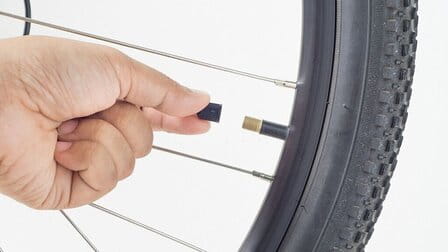Cycling has become a popular sport in recent years and is no longer unfamiliar to us. When cycling on the regular road or other challenging terrains, we should have all of the necessary safety accessories. The helmet is one of them. Definitely, helmets are a must-have accessory for anyone who loves cycling.
Therefore, some essential accessories come with helmets, such as cycling caps for hot weather, also the need for cyclists. Using a cycling cap inside a helmet provides cyclists with more advantages than many people realize. This article will discuss the Benefits of Cycling Caps – answer the question "Why do we need cycling caps for our trip?"
1. Benefits of Cycling Caps

Keep sweat into eyes
Sweating is a natural thing when joining any sport. However, there are a few sports that are difficult to wipe the sweat off of, such as cycling. Instead of using a towel, some cyclists wear cycling gloves as a trick accessory to prevent sweat rain out their eyes. But that's also inconvenient; cyclists can't keep stopping to sweat, especially on sunny days or when it's drizzling. With the cycling caps, its trouble can be solved. The caps can easily keep sweat from dripping into a cyclist's eyes.
Sun shield in summer
Wearing a cycling cap on sunny days is a good idea. Wearing a hat with a brim covers your face and protects it from direct sunlight. Reduce glare and improve vision stability. When you're cycling long distances, and the sun is shining directly in your face, it's easy to get sunburned.
They also protect you from low-light conditions in the spring and autumn, as well as sunrises and sunsets. Caps shine in the spring and autumn, providing a light layer of warmth that shields the head from the effects of vented helmets without overheating the rider, as a thermal cap designed for the winter might.
Keep head warm in Winter

A helmet with as many holes will be challenging to keep warm on cold winter days. Instead, cyclists can keep their heads warm by wearing caps as an accessory. Cycling caps keep your head warm in cold weather by retaining heat and cool in hot weather by wicking moisture and allowing air to circulate. These features make cycling more comfortable and enjoyable, as well as more competitive for the cyclist.
Prevent insects and bugs out of hair

Insects and bugs are one of the most common cycling problems. Many cyclists were unsure how to deal with them and how to avoid them. Cycling caps are a non-existent idea. The insects and bugs will not penetrate your hair. Moreover, the brim of your hat can protect you from insects if you run over them by accident.
Besides, wearing cycling caps is also suitable for your hair, especially for the bald cyclist. Hair management is an added benefit of cycling caps. Cycling caps can keep your hair from becoming tangled liner while you're riding. When you take off your helmet and sit down with your friends after your ride, your cycling cap can keep your hair in place.
Keep your helmet clean
Another benefit of cycling caps is keeping your helmet clean. In fact, they help to keep the inside of your helmet clean, oil-free, and sweat-free, extending the life of the interior parts of your helmet. You will save a lot of time and effort cleaning the helmet with just one hat. Furthermore, cleaning the inside of the hat is frequently tricky. Instead, simply wash the cycling caps to make everything look neater and cleaner.
2. How to wear Cycling Caps

A cycling cap can be worn under the helmet or worn alone. Cycling caps are now brightly colored and feature humorous phrases, making them the ideal complement to your cycling outfit. Because that is the essential function of a cap, their primary function was to protect the rider's head. These cycling accessories can be worn peak up or peak down, regardless of whether or not a helmet is worn.
- Forward-Brim Down: According to the traditional way, the hat's brim should be down, and the back of the cap should be a little higher on the head than the top of your head. If you're riding into the evening, it'll keep the rain (or mud in this case) and wind out of your eyes, as well as bugs. It's also a great way to keep the blinding headlights from the other direction out of your eyes if you're riding at night. Or standing straight ahead, the base of the cap should be angled ever so slightly lower down at the back so that when the peak is down, you can see it but still see ahead.
- Forward-Brim Up: Another way to wear a cycling cap was with the brim flipped up and tight on the head. If you wear the brim-down style above, you'll have a hard time seeing the road ahead if you wear the cap too low or your head is tucked down to stay more aero. When this happens, flipping the brim up will provide you with the visibility you require while leaving the brim in place to be flipped down as needed. This look is also appropriate for when you're wearing a hat to keep your head warm.
But to sum up, it depends on the cycling caps styles, the cyclist can make their own way to wear the caps as long as they feel comfortable and convenient with it. There are thousands of caps choices, popular styles such as forward-brim down, forward-brim up, backward-brim down, backward-brim up.
3. What should you consider before buying the cycling caps?

Size
One of the essential considerations while buying the caps is the size of the cap. A Cycling cap should be on the right size to take all the benefits of cycling caps, it means firmly on the head, but there should be a gap between the top of the cap and your scalp. However, if there is too much of a gap, the cap will resemble a chef's hat.
The cap should not be worn all the way down to your ears or too high on your head. The correct way is slightly higher than ears and has a small loft above your head, but not excessively. You'll also want a brim size that corresponds to the size of your hat; it shouldn't be too big or too small. When you wear cycling caps, make sure it's flat or has a slight curve. It should be free of folds and creases, and it should always sit straight on your head, whether you're facing forward or backward.
Cycling caps material

Based on physical health or weather, the cyclist can choose the correct material. For specific types of cycling, each material has its own set of advantages.
- Wool: Wool is ideal for cold-weather cycling caps because it keeps you warm even when wet. Moreover, with some cycling caps, wool is combined with synthetic fibers like polyester in some fabrics to create a lightweight and durable blend.
- Synthetic: Manufacturers of synthetic apparel use various proprietary and licensed synthetic fabrics, but they usually consist of a mix of polyester, nylon, and spandex. Because synthetics are lightweight and breathable, they can be woven, used in mesh, or used as yarn in fleecy microfiber fabrics. Some are made of UV-resistant fabrics to keep you safe from the sun, while others are treated with a water-repellent coating to keep the rain off.
- Cotton: Cotton caps don't breathe well or keep you warm, especially when your sweat turns cold. However, for off-the-bike style, that should be the 2-in-1 solution. You can wear both cycling or turning it in as an accessory for daily days.
Conclusion
Cycling caps should be standing on the top list of accessories you need to buy when cycling. Above are the benefits of cycling caps that you can consider when owning ones. Have a pleasant cycling trip with gearinstant!













